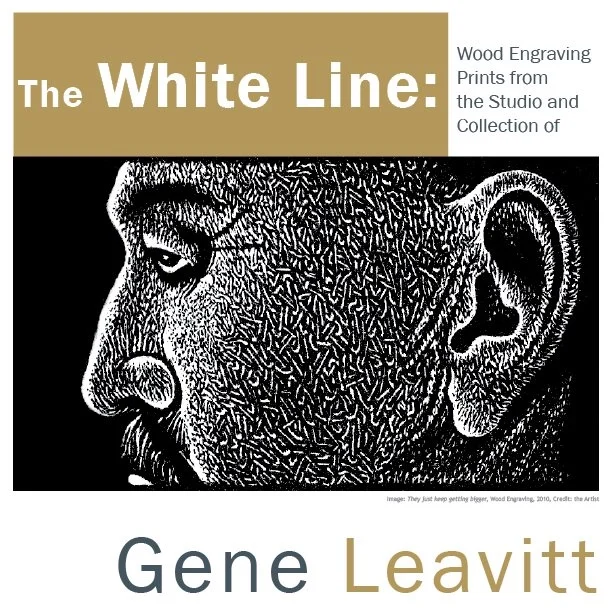The White Line: Wood Engraving Prints from the Studio and Collection of Gene Leavitt
Curated by Rod Taylor
In contrast to much of the digital imagery that surrounds us today, the relief printmaking process of wood engraving is a low-tech, high-precision endeavour. Invented in the 18th century, primarily for book illustration, wood engraving is a refinement of the ancient relief technique of the woodcut, resulting in a far richer tonal range and greater detail.
Artists who choose to work in this medium require both persistence and commitment. Mistakes are not easily undone, and the best results only come with experience, and a considerable amount of trial and error. Only experience will show the right amount of pressure to apply to the burin, the sound the ink makes as it’s properly rolled out. And once the ink is rolled out, how much needs to be applied to the block to neither clog the fine lines nor fail to fully saturate areas of colour.
That’s not to say that wood engravers are a humourless bunch however, or that the slow and deliberate nature of the process in any way limits their creative expression. And although the process does dictate that the size of the work is relatively small, there is much to be seen for those that take the time. So while much of the world moves by at an increasingly frenetic pace, here is an opportunity to slow down, look closely and enjoy the variety and detail of these finely crafted images.
Artist Statement
When I was presented with an opportunity to mount a show at Touchstones Nelson, I chose to focus on wood engraving. I wanted to take advantage of this opportunity to educate people about this intriguing but somewhat obscure medium.
Instead of just showing my work, I chose to make the show more about wood engraving and less about myself. Consequently, I’ve included wood engravings of artists from my personal collection in addition to a cross section of my work over the years. Along with the engravings, I’ve provided examples of blocks, tools and books related to the medium in hopes that the viewer would gain an overview of what’s involved in making a wood engraving.
Due to the nature of working on end grain blocks, most wood engravings are small images that require close examination in order to appreciate the intricate mark making. Take your time, look carefully and I think you’ll enjoy these intimate images.
Visit Gene Leavitt’s website.
The History and Process of Wood Engraving
Invented in the 18th century, primarily for book illustration, wood engraving is a refinement of the ancient relief technique of the woodcut. The end grain used in wood engraving is harder and more durable. This means less material needs to be removed (or carved), making it a faster process. It also allowed for finer marks, resulting in a far richer tonal range and greater detail. The only printing medium that could be simultaneously printed with type as text, it was largely replaced by photographic processes as they emerged in the late 19th and early 20th century.
This low tech, high-skill process is relatively slow and arduous and therefore of little use in modern large-scale book production. Nonetheless, wood engraving and hand-made books have persisted as an art form. There are approximately 20 -30 people doing wood engraving in Canada and roughly 200 in North America.
Looking at these tools, what do you think the process of wood engraving is like? What are the challenges/ advantages of this medium? Wood engraving is a relief printmaking process in which the image is cut into the end grain of a block of wood using engraving tools. Using end grain allows for finer lines and more detail than can be accomplished with a woodcut. Each cut creates a white line. When the cutting is complete, ink is applied to the block with a hard rubber roller called a brayer. Prints can be created with a press, or the paper can be simply placed on the block and burnished, or rubbed with a spoon or other rounded object. Two other common types of relief printmaking are the woodcut and linocut.
Leavitt’s prints are sometimes figurative and humourous (eg. Ear Eye Am). The small size of the prints and the close viewing distance to the subject creates a feeling of intimacy and gives the viewer the impression they are looking through a peep hole. “It fascinated me that at one time during our history, people once believed that alchemists could conjure up some little humanoid that would then wreak havoc on society. Or that there were little human like creatures, “homunculi”, living inside your head that were responsible for making your decisions. I wondered what they might look like in their environment.” – Gene Leavitt
Gene Leavitt will be giving a wood engraving demonstration on Saturday Jan 28th. Visit the Wood Engravers Network (WEN)

